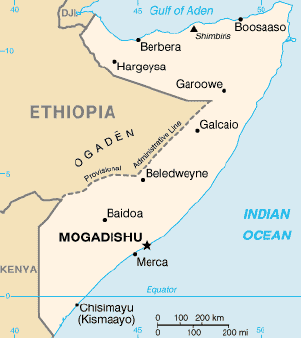| Somalia Table of Contents
Somalia's terrain consists mainly of plateaus, plains, and highlands. In the far north, however, the rugged east-west ranges of the Karkaar Mountains lie at varying distances from the Gulf of Aden coast. The weather is hot throughout the year, except at the higher elevations in the north. Rainfall is sparse, and most of Somalia has a semiarid-to- arid environment suitable only for the nomadic pastoralism practiced by well over half the population. Only in limited areas of moderate rainfall in the northwest, and particularly in the southwest, where the country's two perennial rivers are found, is agriculture practiced to any extent. The local geology suggests the presence of valuable mineral deposits. As of 1992, however, only a few significant sites had been located, and mineral extraction played a very minor role in the economy. Somalia's long coastline (3,025 kilometers) has been of importance chiefly in permitting trade with the Middle East and the rest of East Africa. The exploitation of the shore and the continental shelf for fishing and other purposes had barely begun by the early 1990s. Sovereignty was claimed over territorial waters up to 200 nautical miles.
Climate 
Custom Search
Source: U.S. Library of Congress |
 Africa's easternmost country, Somalia has a land area of 637,540
square kilometers, slightly less than that of the state of Texas.
Somalia occupies the tip of a region commonly referred to as the Horn of
Africa--because of its resemblance on the map to a rhinoceros's
horn--that also includes Ethiopia and Djibouti.
Africa's easternmost country, Somalia has a land area of 637,540
square kilometers, slightly less than that of the state of Texas.
Somalia occupies the tip of a region commonly referred to as the Horn of
Africa--because of its resemblance on the map to a rhinoceros's
horn--that also includes Ethiopia and Djibouti.